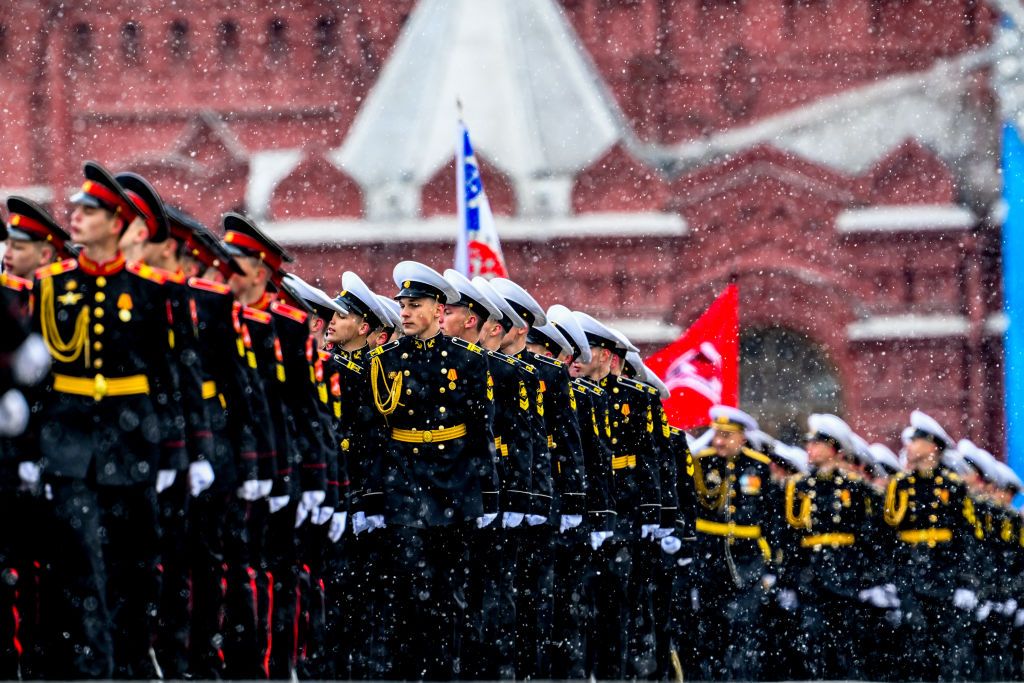
Opinion: No quiet for Europe on the Eastern Front
As the threat from the East persists, Poland, the Baltic states, and Finland continue to arm and construct fortifications along their borders with Russia, Belarus, and (partly) Ukraine.
Police military personnel attend a press conference held by Polish Defense Minister Mariusz Blaszczak at a military camp near Poland's border with Belarus on Aug. 12, 2023. (Attila Husejnow/SOPA Images/LightRocket via Getty Images)

Sławomir Sierakowski
Senior Fellow at Mercator
There is a saying in Poland that, “No one will die for Gdansk.” No matter what kind of security guarantees Poland gets from Western countries, most Poles believe that we will still have to fend for ourselves. After all, when the Nazis invaded in 1939, Poland had security guarantees from Great Britain and France, yet neither country came to its aid (though they did formally declare war on the Third Reich).
Yes, according to Article 5 of the North Atlantic Treaty, an attack on one NATO member is an attack on all, and faith in this mutual-defense commitment remains strong in Poland. U.S. presidents repeatedly vow to “defend every inch” of NATO territory. Yet in an age of hybrid warfare, the duties implied by Article 5 have become blurrier. Moreover, unlike Nazi Germany, the biggest threat to Europe today is armed to the teeth with nuclear weapons.
By constantly signaling that an escalation of the war in Ukraine is one of their greatest fears, U.S. and German leaders have not exactly inspired confidence in the NATO security guarantee. How they would respond if Russia invaded Estonia, for example, is not clear – especially at a time when European armies and arms industries are so weak. Poland itself has sent more tanks to Ukraine than the United Kingdom has.
In this context, Poland and the Baltic countries have decided not only to arm, but also to devote considerable resources to building up fortifications along their borders with Russia, Belarus, and (partly) Ukraine. In Poland, this plan goes under the official title of “Shield East,” but it has already come to be known as the “Tusk Line” – a reference to current Polish Prime Minister Donald Tusk and the famous French Maginot Line in World War II.
The Polish government has earmarked 10 billion zloty ($2.6 billion) for the project, which it plans to complete by 2028. But this sum seems insufficient. The fence on the border with Belarus alone (built by the previous government) cost 1.6 billion zloty ($404 million), and it often failed to block the flow of migrants that Russia and Belarus were foisting on Poland in recent years.
Nonetheless, what matters is that the Polish public is willing to make large financial sacrifices for the country’s defense. Moreover, Poland is also counting on help from the European Union, where there is a growing awareness of the Russian threat. Given that Poland’s border with Russia and Belarus is also the EU’s eastern border, it makes sense that it should be protected through joint EU efforts. While Poland’s previous, illiberal government refused to join the German-led “Iron Dome” initiative – owing to its irrational Germanophobia – Tusk’s government recently corrected this strategic mistake.

Poland and the Baltic countries are in a slightly different strategic position than Finland. Not only does Finland boast an excellent army, a well-trained population, and a huge number of bomb shelters, but – most importantly – its large, sparsely populated, heavily wooded terrain would complicate matters for any invader. The Finns thus assume that they can afford to let an enemy into the country and still mount an effective defense. Success or failure does not hinge on the security of the border.
The Baltics, by contrast, recently determined that they need a linked chain of fortifications on their eastern borders – a “Baltic Defense Line” – to prevent an invading force from driving deeper into their territory. Under a recently agreed joint plan, Baltic governments will build around 600 fortified bunkers in Estonia alone, at a cost of some $64 million, and establish 18 “counter-mobility parks” – rapid-deployment hubs for anti-personnel and anti-vehicle equipment (like tank traps) – in Lithuania.
Poland’s Tusk Line will be structured similarly, but with much more emphasis on creating some 700 kilometers (434 miles) of natural guardrails. “The main priority is to take care of the transportation infrastructure, which is sorely lacking at our eastern border,” according to General Mieczyslaw Bieniek, an adviser to Polish Defense Minister Tomasz Siemoniak. “Fortifications, bunkers or shelters alone will not deter anyone. We need to be able to cover these areas with fire positions and military units that will defend the security of our border.”
Swamps, floodplains, dams, dense forests, and other natural barriers will need to be used fully, and new barriers created, so that Polish forces are prepared to establish safe and effective firing redoubts, plan ambushes, organize supply centers, and channel enemy forces to vulnerable positions. Poland will also rely heavily on anti-drone defenses and satellite and aerial reconnaissance. To that end, it recently acquired U.S. reconnaissance aerostats technology (under a U.S. program code-named “Barbara”) that can detect targets up to several hundred kilometers away.
Despite their apparent differences, the Finnish, Baltic, and Polish eastern-defense plans are compatible, because they share the same basic goal. And they are being developed in close consultation with EU leaders in Brussels, where efforts are underway to create a new joint-defense commissioner position to coordinate and reconstitute the European arms industry.
But no plan or border-defense belt can secure the EU if it does not adequately support Ukraine in its fight against Russia. If Russian forces gain control of Ukraine, that will undermine all of Poland, Finland, and the Baltic countries’ plans. Since it will be years before the Baltic and Tusk Lines are built, the Ukrainian battlefield remains the highest priority.
Editor’s Note: Copyright, Project Syndicate. This article was published by Project Syndicate on June 4, 2024, and has been republished by the Kyiv Independent with permission.The opinions expressed in the op-ed section are those of the authors and do not purport to reflect the views of the Kyiv Independent.












